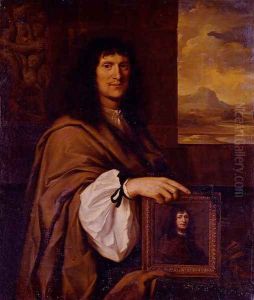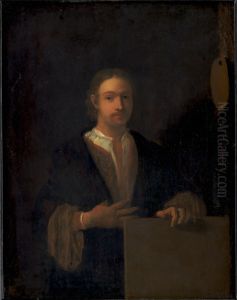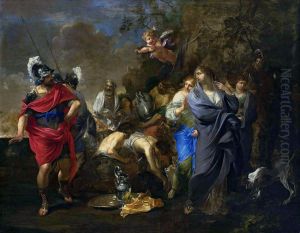Charles Alphonse Du Fresnoy Paintings
Charles Alphonse Du Fresnoy was a French painter and writer on art, born in Paris in 1611. He was the son of an apothecary and initially embarked on a classical education. However, his passion for painting soon became evident, and he began studying under the guidance of painters such as François Perrier and Simon Vouet. Despite his training in painting, Du Fresnoy is best remembered for his contributions to art theory and criticism.
Du Fresnoy's career as a painter was modest, and he spent a significant amount of his life traveling through Italy, which was the epicenter of the art world during the 17th century. His travels and studies in Italy deeply influenced his understanding of art, particularly the works of the Renaissance and classical antiquity. During his time in Rome, he became associated with Nicolas Poussin, who was a significant influence on him. Poussin's classicism and emphasis on drawing and composition would echo in Du Fresnoy's later writings.
In 1656, Du Fresnoy moved to Venice, where he studied the color theories of the Venetian masters, which further enriched his knowledge and theoretical approach to painting. He returned to Paris in 1663 and continued to work and write, although he never achieved great fame as a painter.
His most famous work is 'De Arte Graphica' (On the Art of Painting), which was published posthumously in 1668, the year of his death. This treatise on painting was written in Latin verse and was translated into several languages, including English by John Dryden. 'De Arte Graphica' was highly influential and was considered a seminal text for classical art theory. It emphasized the importance of drawing, composition, and the study of the great masters from antiquity and the Renaissance. Throughout his theoretical work, Du Fresnoy advocated for an academically grounded approach to painting that valued historical knowledge and artistic discipline.
Charles Alphonse Du Fresnoy died in Paris in 1668. Although he is not widely remembered as a painter today, his contributions to art theory continue to be recognized by art historians and scholars. His work has had a lasting impact on the understanding of classical art principles and has influenced generations of artists and thinkers in the field of aesthetics.


